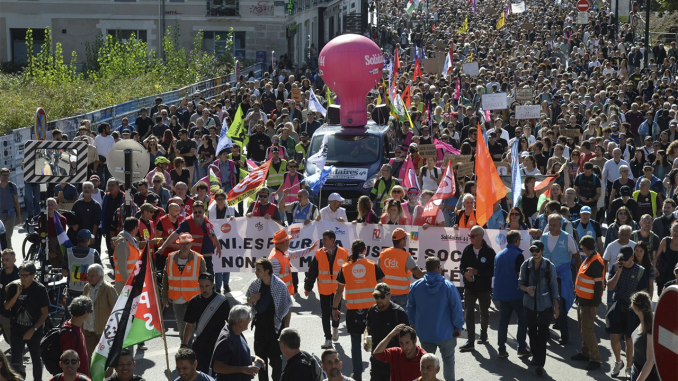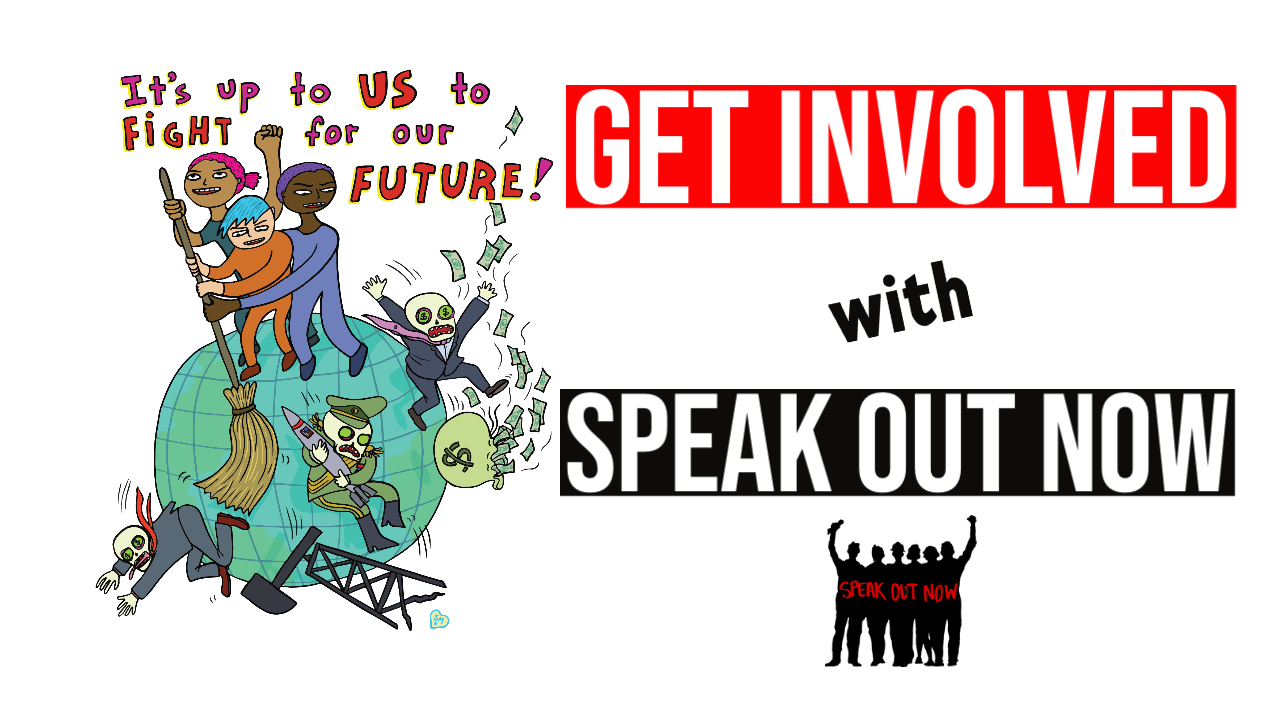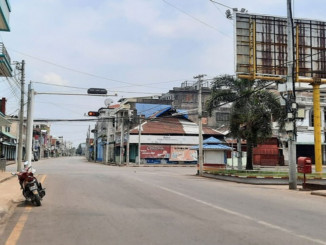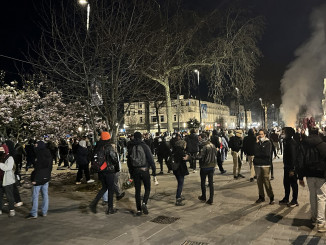
From a correspondent in France
On Wednesday, September 10, and then again on Thursday, September 18, France experienced two days of major social unrest against the budget cuts announced for 2026. Between recurring political crises, worsening inequalities, and growing fears of being dragged into a “real” war, it is in fact a deeper anger that explains the scale of popular participation. Let’s take a look at its causes and sketch out some perspectives.
A social war budget
The first warning signs date back to last winter. When Trump decided to reverse U.S. imperialism’s support for Ukraine last February, the French media began hammering home the need to rearm in the face of the Russian “ogre.” How to find the money? By cutting social spending. Self-proclaimed experts each put forward their own ideas. The director of Bpifrance, a public bank, stood out by advocating the destruction of the pension system: “leisure time for these fake old people who are 62, 65, 66, 70 years old, who are in fact really young.”
However, the governing party does not have a majority in the National Assembly. This situation has been going on since the legislative elections in the summer of 2022. President Macron made his camp’s situation worse when he decided to dissolve the Assembly in the summer of 2024: his party narrowly avoided almost complete wipeout, with its candidates benefiting from the left-wing parties’ call to vote for them in the second round against the far-right RN (National Rally) party.
Bayrou, already the second prime minister since the dissolution of the Assembly, is supported by a fragile minority coalition of right-wing, Macronist and non-Macronist deputies. Without the support, or at least the abstention, of the left or the far right, he cannot pass laws or govern. Nevertheless, he decides not only to continue the current austerity measures, amounting to nearly €10 billion ($12 billion) per year, but to significantly increase them. In the spring, he announced budget cuts of around €40 billion. According to him, the public debt leaves no room for respite. And too bad if its recent increase (Covid crisis) or older increase (2008 global financial crisis) is due to massive aid distributed to capitalists under the pretext of saving the economy. On July 15, he specified how he intends to bleed the population dry: the elimination of two public holidays, the extension to seven days of the waiting period before sick leave compensation—in other words, the disappearance of the very concept of sick leave, with compensation for long-term illnesses such as cancer also being called into question… the elimination of 3,000 civil service jobs, and many other measures of the same kind.
In the service of parasitic capitalism
Certain measures, such as the end of reimbursement for certain drugs, affect the social security budget. The state is effectively claiming the right to dip into the contributions paid by employees and employers into social security funds… before demanding that these funds balance themselves. As a result, huge amounts of money are transferred each year from public funds to the coffers of large companies, €211 billion according to the Senate, and as much as €270 billion according to a recent book published by two specialist journalists.
When we consider that €98 billion of the €145 billion in profits made in 2024 by the CAC 40 (the 40 largest French companies) ended up as dividends and share buybacks (to destroy them and drive up the stock price of the remaining shares), we can appreciate the particularly parasitic nature of French capitalism.
However, this is starting to become apparent and widely known. In the middle of summer, unknown individuals launched an appeal that spread like wildfire on social media. Although the period from July 15 to August 15 is the off-season for protests—most companies slow down during this vacation period—Telegram conversations flourished, giving substance here and there to the slogan “On September 10, we’re blocking everything.” The first meetings brought together a few groupings. But soon there were dozens, and by the end of August, hundreds. A reaction had begun that no one could control.
Unions nowhere to be seen
The first merit of the call to block everything is that it has shaken the trade union confederations out of their lethargy. This lethargy dates back well before July 15. The union leaderships had remained almost completely passive in the face of the campaign to prepare public opinion for social “sacrifices” in the spring.
Admittedly, it may have been premature to call for a strike at that point. However, an information and agitation campaign among employees to analyze the threat and prepare a response was necessary. The unions did not launch such a campaign after the summer break either. A few of the more combative unions, such as the Sud-Rail railway workers’ union, called for a strike fairly quickly and without reservation on Wednesday, September 10. Others, including the CGT confederation, rallied after much hesitation, and without endorsing a clear call to action everywhere. Finally, the wing of the trade union movement most integrated into the state apparatus, led by the CFDT, simply snubbed September 10. This was not without internal turmoil. In the Manche department (a northern region), for example, where industry is less important than cattle farming, the CFDT agri-food union called for a strike on September 10 and was present at the roundabouts.
In the end, at the end of August, the eight main trade union confederations called for a strike on September 18. But this was not to support the movement, rather to take the lead and better channel it.
The far right rows in the opposite direction
In the early days of the call to block everything on September 10, the far right was probably not unhappy to see Bayrou in a difficult position. Here and there, it tested the waters to see if its anti-immigrant and anti-poor demagoguery could find a connection, or even an amplifier.
For months, the meme “Nicolas is paying” has presented itself as the voice of a supposed middle class that alone pays taxes for the exclusive benefit of the poor and foreigners. But it quickly learned its lesson. On the one hand, anger is directed as much at capitalists, particularly banks and supermarkets, as it is at the state and the tax authorities. On the other hand, unlike at the beginning of the Yellow Vests movement (2018-2020), left-wing and far-left activists were fully involved in setting up the first networks. In many places, those promoting far-right ideas (whether activists or not, it is difficult to know…) were silenced or even ejected from the conversations.
Above all, the flagship party of the French far right, the RN, is already on the verge of power. More than winning over the last million voters it needs, its priority is to be endorsed by employers. Its program of social demagoguery has already been seriously curtailed in the legislative elections of summer 2024. There is no longer any question of retirement at 60, for example. So, this is not the time for it to stir up the embers of revolt. Instead, it is trying to slander the movement. Contrary to the evidence, it claims that it is being manipulated by the unions. It denounces the call to block everything as the work of the left-wing party La France Insoumise (LFI), aided by statements from its leader Jean-Luc Mélenchon, who called for a general strike as if he had the power to bring one about. To all those whom he accuses of wanting to sink the country and plunge it into crisis, the RN opposes its brand new “sense of responsibility”: it is waiting patiently for its turn to win the elections…
A successful September 10, but…
The pressure from the far right has weighed heavily on working-class circles, leading to a certain wait-and-see attitude. There are those who oppose the strike, a weapon of class struggle, with conspiracy theories: shopping with cash rather than credit cards to bring down the banks. There are those who are wary of seeing their struggle used to put a vaguely patched-up (the Socialist Party) or completely revamped (LFI) left-wing government back in power. They prefer to rely on the RN. There are those who are repelled by the language and political markers of the initiators of the September 10 movement: they would like to see French flags instead of Palestinian flags at demonstrations, and denounce taxes but refuse to increase social assistance for the so-called “welfare recipients.”
This wait-and-see attitude has been strong enough to dissuade some trade unionists from calling for strikes, even when their confederation did so, or from wearing their badges, vests, or flags in demonstrations that were supposed to remain “civic,” i.e., neutral or even apolitical. At the same time, the strike, which was fairly minor overall, took hold here and there, in unexpected places, among people who had never gone on strike before and who were not discouraged by their isolation in the workplace. The demonstrations were numerous and fairly strong, especially when they took place after work and school. Young people were the most dynamic element in these demonstrations. In the end, it was the blockade actions that proved most disappointing. Interior Minister Retailleau was certainly unable to nip them in the bud as he had promised. But in many cases, participation was limited to the organizers’ small circle of supporters. Among the latter, union and left-wing activists were overrepresented. Nowhere was the call to block everything followed by masses of unorganized workers, as was the case during the Yellow Vests movement. Not enough to change the situation, then. But enough to give social anger its first expression and restore confidence to all those who were raging on their own, imagining themselves to be alone. At the risk, sometimes, of believing that they already represent the majority, when everything remains to be done to convince the bulk of the working class to join the struggle.
September 18…
In war, the attacker takes the initiative and puts the opponent on the defensive. That is what we did on September 10. Thursday, September 18 amplified this mobilization. The marches were larger everywhere, as were the numbers of strikers. And for good reason: this time, even the most timid unions were calling for action, and without hesitation. As is often the case in France, this union unity—albeit superficial—encourages people to strike. Actions of all kinds (blockades, picket lines, general assemblies, etc.) energized it. The slogans on the handmade signs responded to a much broader spectrum of concerns than the vague objectives set by the union leaders who initiated this second day of mobilization.
At the end of the day, what did these same leaders propose? To wait for the new Prime Minister Lecornu to respond to an “ultimatum.” As if he were going to deviate one bit from the policies of his predecessors, when he has been part of most of the governments of the Macron era! Under a radical veneer, this amounts to passing the buck back to him and diverting the struggle to an institutional arena where the strongest are the capitalists, the rich, the bourgeois class that never lacks politicians to serve it.
…and then what?
To force the government and employers to back down, successful strike days are not enough: we saw this in 2023 with the movement against pension cuts, which consisted of fifteen strike days scattered over five months. Millions of workers took part, some throughout, others in turns.
In the end, the government pushed its bill through by decree without parliamentary approval. What is needed is a strike that spreads across all workplaces and lasts long enough to paralyze the profit machine.
Such a movement cannot be satisfied with demanding a “better budget” or setting “conditions” for the continued plundering of hundreds of billions of euros of our taxes by large corporations: we know in advance that these “conditions” would be circumvented, including with the help of senior officials, in order to continue feeding the richest! Who would go on strike to tax at 2% (a proposal by the Socialist Party, supported behind the scenes by certain unions) fortunes that have quadrupled since Covid? Or to “freeze” the increase in the minimum retirement age at 63 instead of 64 (a demand by the CFDT confederation)?
For millions of workers to risk their pay, and for the most precarious to risk their jobs outright, it has to be worth it: wage increases that push the end of the month from the 15th to the 30th, new hires that put an end to hellish work rates, and much more. This is our lives we’re talking about: no one is better placed than us to know what we need. It’s up to us to determine our demands. In this movement, which is only just beginning, this may well be the next step.




